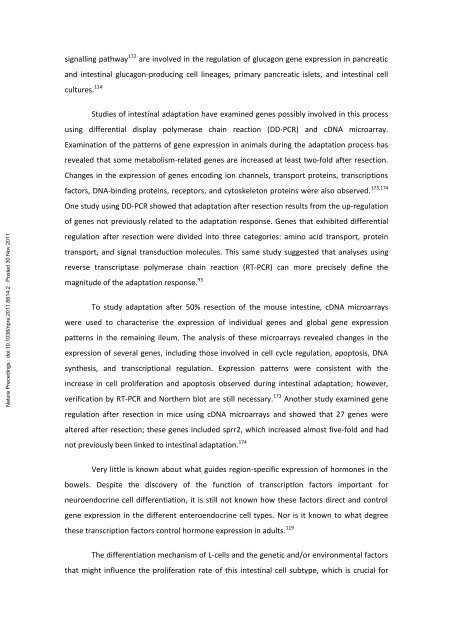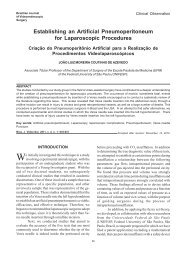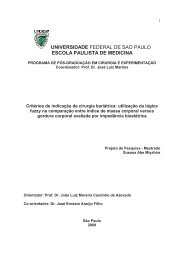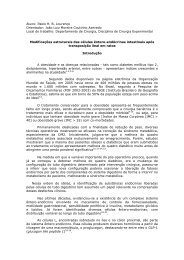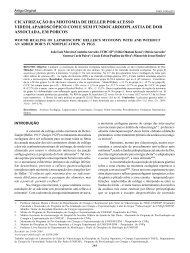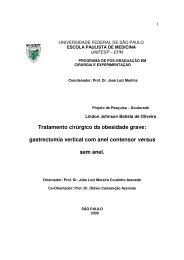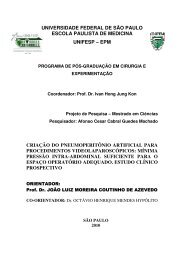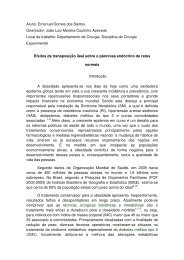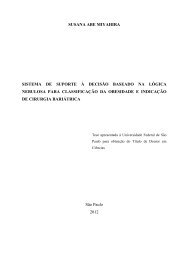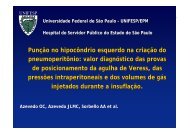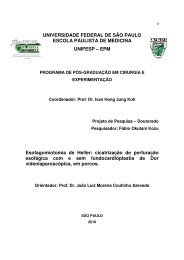Isolated ileal interposition in enteroendocrine L cells differentiation
Isolated ileal interposition in enteroendocrine L cells differentiation
Isolated ileal interposition in enteroendocrine L cells differentiation
You also want an ePaper? Increase the reach of your titles
YUMPU automatically turns print PDFs into web optimized ePapers that Google loves.
signall<strong>in</strong>g pathway 172 are <strong>in</strong>volved <strong>in</strong> the regulation of glucagon gene expression <strong>in</strong> pancreatic<br />
and <strong>in</strong>test<strong>in</strong>al glucagon-produc<strong>in</strong>g cell l<strong>in</strong>eages, primary pancreatic islets, and <strong>in</strong>test<strong>in</strong>al cell<br />
cultures. 114<br />
Studies of <strong>in</strong>test<strong>in</strong>al adaptation have exam<strong>in</strong>ed genes possibly <strong>in</strong>volved <strong>in</strong> this process<br />
us<strong>in</strong>g differential display polymerase cha<strong>in</strong> reaction (DD-PCR) and cDNA microarray.<br />
Nature Preced<strong>in</strong>gs : doi:10.1038/npre.2011.6614.2 : Posted 30 Nov 2011<br />
Exam<strong>in</strong>ation of the patterns of gene expression <strong>in</strong> animals dur<strong>in</strong>g the adaptation process has<br />
revealed that some metabolism-related genes are <strong>in</strong>creased at least two-fold after resection.<br />
Changes <strong>in</strong> the expression of genes encod<strong>in</strong>g ion channels, transport prote<strong>in</strong>s, transcriptions<br />
factors, DNA-b<strong>in</strong>d<strong>in</strong>g prote<strong>in</strong>s, receptors, and cytoskeleton prote<strong>in</strong>s were also observed. 173,174<br />
One study us<strong>in</strong>g DD-PCR showed that adaptation after resection results from the up-regulation<br />
of genes not previously related to the adaptation response. Genes that exhibited differential<br />
regulation after resection were divided <strong>in</strong>to three categories: am<strong>in</strong>o acid transport, prote<strong>in</strong><br />
transport, and signal transduction molecules. This same study suggested that analyses us<strong>in</strong>g<br />
reverse transcriptase polymerase cha<strong>in</strong> reaction (RT-PCR) can more precisely def<strong>in</strong>e the<br />
magnitude of the adaptation response. 93<br />
To study adaptation after 50% resection of the mouse <strong>in</strong>test<strong>in</strong>e, cDNA microarrays<br />
were used to characterise the expression of <strong>in</strong>dividual genes and global gene expression<br />
patterns <strong>in</strong> the rema<strong>in</strong><strong>in</strong>g ileum. The analysis of these microarrays revealed changes <strong>in</strong> the<br />
expression of several genes, <strong>in</strong>clud<strong>in</strong>g those <strong>in</strong>volved <strong>in</strong> cell cycle regulation, apoptosis, DNA<br />
synthesis, and transcriptional regulation. Expression patterns were consistent with the<br />
<strong>in</strong>crease <strong>in</strong> cell proliferation and apoptosis observed dur<strong>in</strong>g <strong>in</strong>test<strong>in</strong>al adaptation; however,<br />
verification by RT-PCR and Northern blot are still necessary. 173 Another study exam<strong>in</strong>ed gene<br />
regulation after resection <strong>in</strong> mice us<strong>in</strong>g cDNA microarrays and showed that 27 genes were<br />
altered after resection; these genes <strong>in</strong>cluded sprr2, which <strong>in</strong>creased almost five-fold and had<br />
not previously been l<strong>in</strong>ked to <strong>in</strong>test<strong>in</strong>al adaptation. 174<br />
Very little is known about what guides region-specific expression of hormones <strong>in</strong> the<br />
bowels. Despite the discovery of the function of transcription factors important for<br />
neuroendocr<strong>in</strong>e cell <strong>differentiation</strong>, it is still not known how these factors direct and control<br />
gene expression <strong>in</strong> the different enteroendocr<strong>in</strong>e cell types. Nor is it known to what degree<br />
these transcription factors control hormone expression <strong>in</strong> adults. 119<br />
The <strong>differentiation</strong> mechanism of L-<strong>cells</strong> and the genetic and/or environmental factors<br />
that might <strong>in</strong>fluence the proliferation rate of this <strong>in</strong>test<strong>in</strong>al cell subtype, which is crucial for


